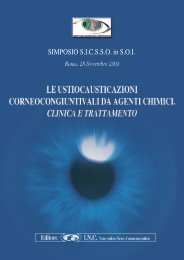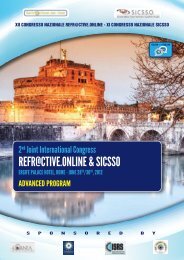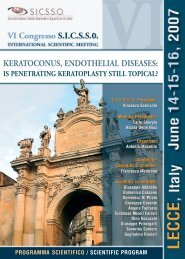1st EuCornea Congress
1st EuCornea Congress
1st EuCornea Congress
Create successful ePaper yourself
Turn your PDF publications into a flip-book with our unique Google optimized e-Paper software.
<strong>1st</strong> <strong>EuCornea</strong> <strong>Congress</strong> venice, 17-19 june 2010<br />
INVITED SPEAKERS<br />
Stoiber, Josef<br />
Visual rehabilitation with the Boston keratoprosthesis<br />
J. Stoiber, J. Ruckhofer, G. Grabner<br />
Paracelsus Medical University Salzburg, Austria<br />
Purpose: Implantation of a keratoprosthesis is the last resort in visual<br />
rehabilitation in patients with bilateral severely damaged ocular surface not<br />
amenable to conventional corneal transplantation or surface reconstruction.<br />
Development of the Boston keratoprosthesis was started in the sixties by<br />
Claes Dohlman. Changes in design and the postoperative regimen led to<br />
further improvement of medium and long term prognosis. We describe the<br />
outcome of the first patients receiving a Boston keratoprosthesis at the<br />
Salzburg University Eye Clinic.<br />
Methods: Within the last 30 months implantation of a Boston<br />
keratoprosthesis was performed in 12 patients. Most frequent indications<br />
were ocular burn, followed by multiple corneal graft failure. Results:<br />
Implantation of the Boston keratoprosthesis could be performed without<br />
major complications in all patients. Improvement in visual acuity could be<br />
obtained in most of the patients, one patient even achieving 20/25 vision.<br />
Conclusion: Indication for the Boston keratoprosthesis include severe<br />
corneal burn and bullous keratopathy following multiple corneal graft failure.<br />
It represents an additional option for visual rehabilitation in eyes with<br />
severely impaired ocular surface.<br />
Tan, Donald<br />
Clinical trial results of endothelial keratoplasty with<br />
the EndoGlide donor inserter<br />
D. Tan, J. Mehta, Wb. Khor<br />
Singapore National Eye Clinic Singapore<br />
Purpose: To describe safety and efficacy and endothelial cell loss rates<br />
in DSAEK with the Tan EndoGlide, a new DSAEK donor inserter, in our first<br />
clinical cases within a clinical trial setting.<br />
Methods: The EndoGlide (Angiotech, USA, and Network Medical<br />
Products, UK) is a new disposable donor inserter for DSAEK surgery. The<br />
design incorporates double-coiling of the donor lamella within a sealed,<br />
clear plastic chamber, with no endothelial touch. The chamber is inserted<br />
through a 4.5mm wound into the AC with an anterior glide to prevent iris<br />
prolapse, and the donor is pulled through into the AC with intraocular<br />
forceps. We performed EndoGlide assisted DSAEK in the first 30 Asian<br />
patients within an IRB approved prospective, non-randomized clinical trial.<br />
Outcome measures included ease of donor insertion, primary graft failure<br />
and donor dislocation rates, and endothelial cell loss up to 12 months.<br />
Results: Indications included PBK/ABK (n=14), Fuchs dystrophy (n=12),<br />
and others (PPMD, DM detachment, failed DSAEK: n=4). Procedures<br />
included DSAEK alone (n=19) and phaco-DSAEK (n=11). Successful donor<br />
coiling was achieved and the Endoglide delivered the donor safely into the<br />
AC with no AC collapse at any stage, and with minimal endothelial touch in<br />
all cases. No cases of primary graft failure or donor dislocation occurred.<br />
Mean endothelial cell loss at 3 months (20 eyes), 6 months (18 eyes) and<br />
12 months (6 eyes) was 10.1%, 13.7% and 19.0% respectively.<br />
Conclusion: Our first clinical cases confirm that the Tan EndoGlide<br />
simplifies donor insertion, has a short learning curve, and appears to be<br />
safe and effective. Relatively low endothelial cell loss rates in the first year<br />
compare very favourably to all other published endothelial cell loss rates in<br />
the current literature.<br />
Terry, Mark<br />
Descemet’s membrane endothelial keratoplasty (DMEK):<br />
Promises and Problems<br />
M. Terry<br />
Devers Eye Institute Oregon USA<br />
Methods: The peer-reviewed published literature was reviewed for DMEK<br />
and compared to published literature of a single center series of DSAEK.<br />
Outcomes of visual acuity and outcomes of the complications of primary<br />
graft failure (PGF), dislocation and endothelial survival were compared.<br />
Results: The only published cases of DMEK were by Dr. Melles (n=50)<br />
and by Dr. Price (n=60). These were compared to those of Dr. Terry<br />
(n=160). The visual acuity of DMEK at 3 months (mean Va=20/25) was<br />
superior to that of DSAEK (mean Va=20/30) at 6 months and DMEK had<br />
a higher % of eyes that were 20/20 or better (26%) than that of DSAEK<br />
(13%). However, all complication rates were higher for DMEK than DSAEK<br />
with PGF rate for DMEK of 16% and DSAEK of 0% and a re-bubbling rate<br />
of 63% for DMEK and 1.8% for DSAEK. The endothelial cell loss of both<br />
procedures at 6 months appears to be about the same at 28%.<br />
Conclusions: While the visual results of DMEK appear to be about<br />
one line better than DSAEK, the complications of PGF and dislocation are<br />
dramatically higher with DMEK than with DSAEK.<br />
Toro, Patricia<br />
DALK in herpes simplex corneal opacities<br />
P. Toro<br />
Misericordia Hospital Grosseto Italy<br />
Purpose: To report our experience with deep anterior lamellar keratoplasty<br />
(DALK) for the treatment of corneal opacities following herpetic keratitis<br />
Setting: Fifty two eyes with post-herpetic stromal scars with intact<br />
endothelium treated with DALK between 2002 and 2006 at Misericordia<br />
Hospital<br />
Methods:The main outcome were the ability to successfully expose DM<br />
(dDALK), the number of cases with predescemetic plane (pdDALK), pre and<br />
postoperative visual acuity and endothelial cell count. The mean follow-up<br />
period was 31 months. Therapeutic protocol, recurrence of herpetic keratitis<br />
and corneal rejection were evaluated.<br />
Results: Descemetic DALK (dDALK) was done in 45/52 cases (86,5%),<br />
while pdDALK was done in 7/52 cases (13,5%). Ruptures of Descemet’s<br />
membrane occurred in 2/52 cases (3,8%) in our series. Postoperative BSCVA<br />
was 20/20 in 27/52 cases (52%) and at least 80% of patients achieved 20/30<br />
at long term follow-up. Average endothelial cell loss was 205,32 cell/mm2.<br />
Therapeutic protocol was conducted with long-term therapy with oral antiviral<br />
drugs and topic steroids after DALK.<br />
Conclusions: DALK is an alternative and safe procedure to restore vision<br />
in cases with significant corneal scarring due to recurrent HSV keratitis with<br />
healthy endothelium. Pre and postoperative antiviral prophylaxis is necessary<br />
to prevent recurrence<br />
FINANCIAL DISCLOSURE: 0<br />
Traverso, Carlo<br />
Cornea & Glaucoma<br />
C. Traverso<br />
Clinica Oculistica, Di.N.O.G., University of Genova, Genoa, Italy<br />
Glaucoma worsening is the leading cause of irreversible visual loss after<br />
perforating keratoplasty (PKP) attributable to optic nerve damage. The<br />
incidence of post-PK glaucoma varies from 9% to 31% in the early and<br />
late postoperative period. The incidence of postoperative IOP elevations is<br />
associated with the preoperative diagnosis of corneal disease. While the<br />
lowest incidence is commonly detected in patients with keratoconus, bullous<br />
keratopathy, graft rejection, previous glaucoma presence and trauma have<br />
been reported to be high risks factors.<br />
Purpose: As Endothelial Keratoplasty (EK) continues to evolve, newer<br />
forms of this surgery need to be evaluated in terms of benefits and risks.<br />
This evaluation must be done in a scientific manner, comparing known<br />
outcomes and complications of each technique of EK.<br />
37







